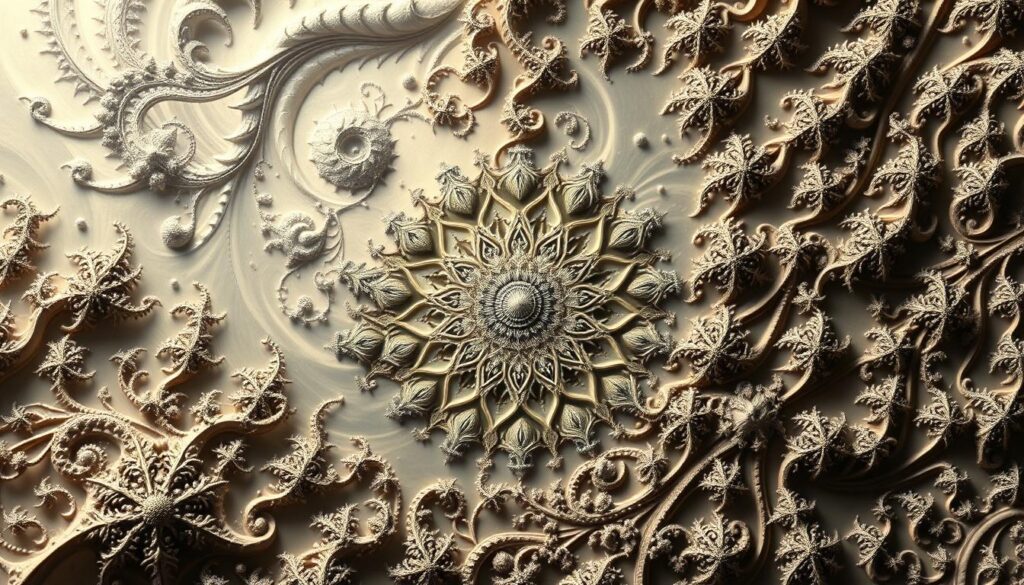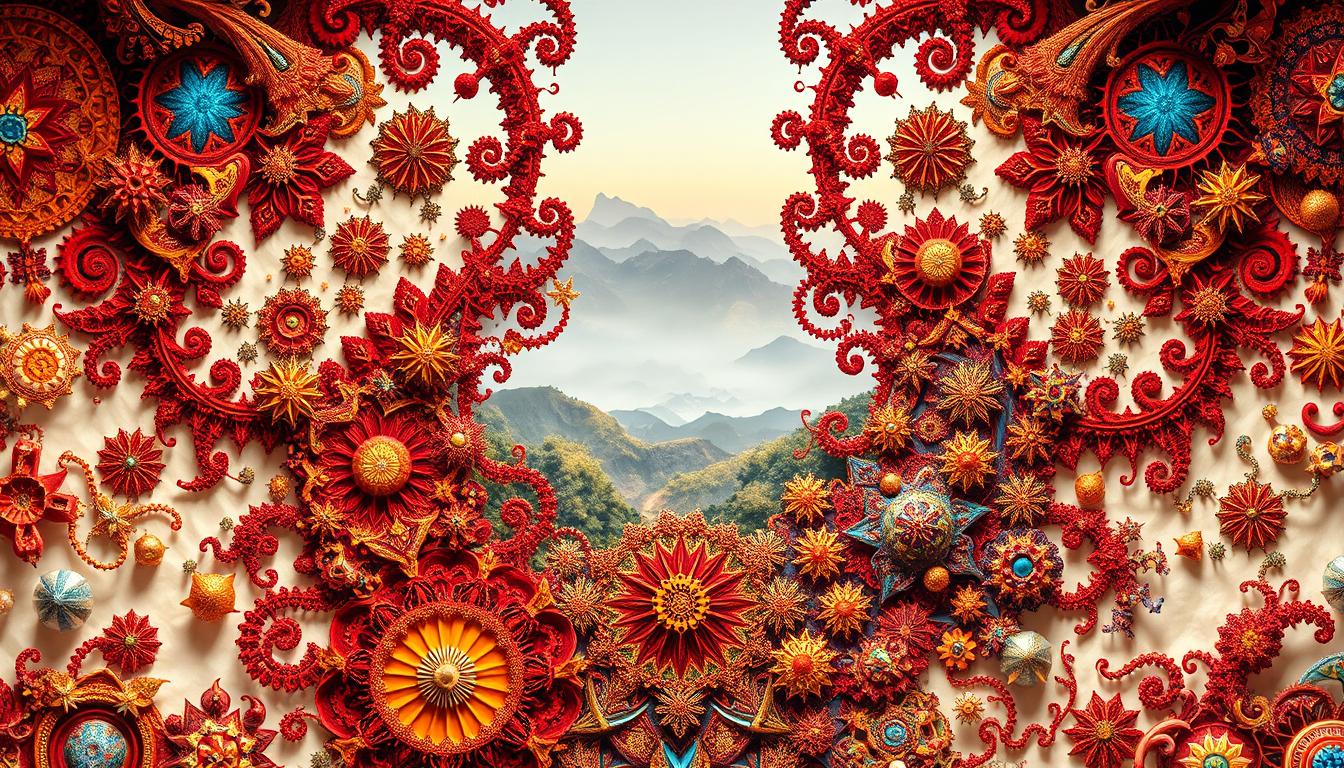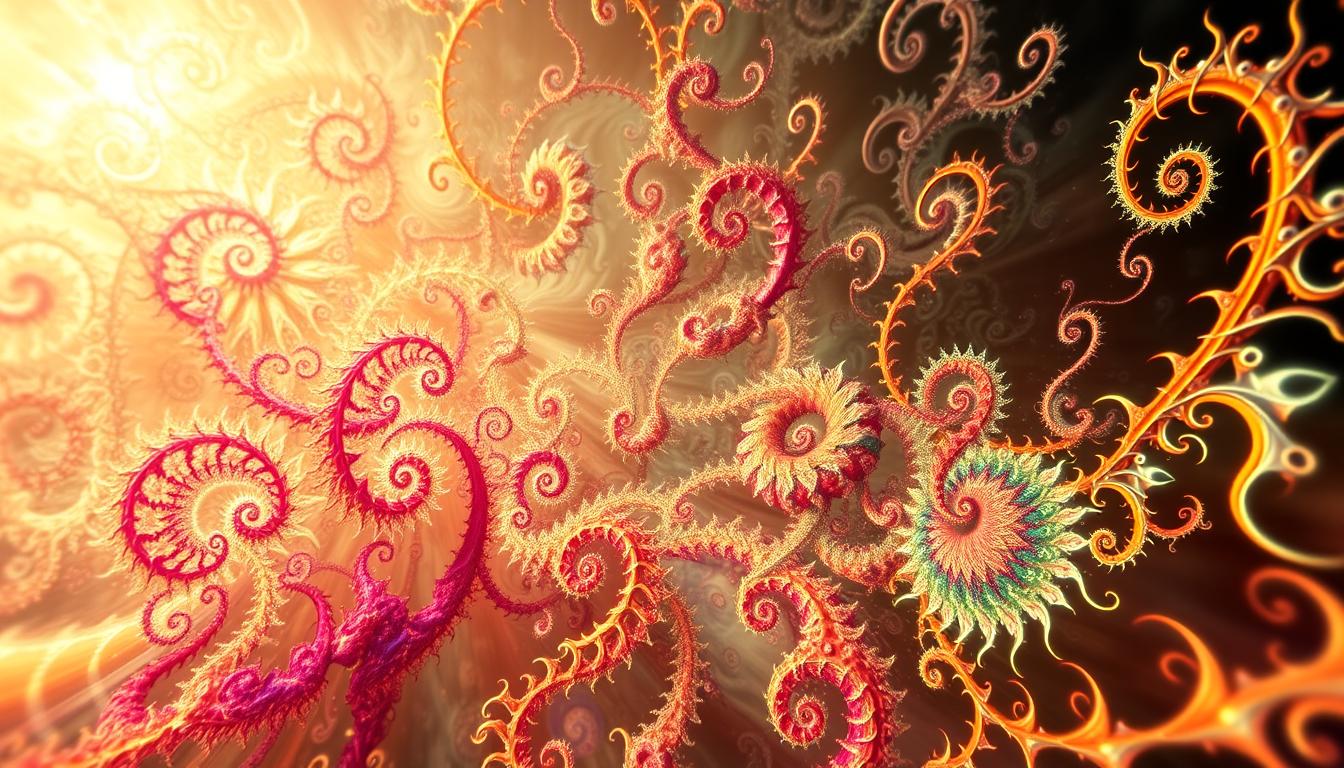Fractal symbolism speaks to us deeply, combining math, art, and mystery. It shows truths about life through complex patterns. These patterns do more than please the eye; they link our feelings with the universe. Through fractals, we see connections in our world.
Learning about fractals opens up understanding for us. It links thinking and feelings in a strong way. As we explore these symbols, we find out more about life’s meanings.
Understanding Fractal Symbolism
Fractal symbolism is a special way of sharing ideas that isn’t like regular language. Think of it as a picture language. It uses patterns that repeat to show deep meanings. The meanings of these patterns come from how they relate to each other, showing a mix of order and chaos in nature and life.
Using fractals helps people see complex connections around them. These patterns are like those found in nature. By looking at these patterns, one can understand how things in nature and human actions are linked. This way of seeing things helps us feel and know more about how life’s pieces fit together.

The Roots of Human Perception
Human perception is key to how we connect with the world. We’ve always had the knack to spot patterns. This skill comes from a deep understanding in our brains. Before words were a thing, humans learned by seeing and doing. This skill lets us grasp emotions and meanings in what we experience.
Seeing patterns affects how we handle what comes our way. As we go through life, we link different signals together. This helps us become more aware of our environment. It also makes us better at making choices based on what we’ve learned before.
People often see the world by linking things together. This shows that smarts and knowing things aren’t just about talking. How we see and interact with everything around us shows the true power of our intuition. It unveils a complex system that shapes our personal stories.
Interpreting the Language of Fractal Symbolism
Fractal symbolism offers a deep look into our past and culture. By studying fractals, we uncover how societies use patterns to share ideas. Through artifacts and myths, we see fractals’ importance across different cultures and times.
The Historical Context of Fractals in Culture
Many cultures have used fractals in art and architecture for centuries. These fractal patterns are found in ancient buildings and crafts, showing their deep cultural value. Notable examples include:
- Islamic art, with its detailed patterns that mirror the endless nature of fractals.
- Native American artwork that mimics nature’s cyclical patterns.
- Ancient Chinese paintings using fractals to symbolize harmony and balance.
The Connection Between Nature and Fractal Patterns
Nature is full of fractals, from the way trees branch to coastline shapes. Observing these patterns helps us understand our world better. Here are some examples:
- Trees have self-similar structures at different sizes.
- Coastlines feature complex, detailed shapes.
- Clouds show intricate, fractal-like patterns.
This link between fractals and nature shows us the beauty of our world. It helps us grasp both the tangible and the abstract, enriching our understanding.
AI and Fractal Recognition
The integration of AI in fractal recognition is a big leap forward in technology. It lets computers look at complex patterns and structures that are often too difficult for people to understand. With smart algorithms, AI systems can see connections and trends in data, making things better in finance, healthcare, and environmental science.
The Role of Artificial Intelligence in Detecting Patterns
AI pattern recognition is key in finding hidden patterns in huge amounts of data. Algorithms are made to learn from repeating structures, helping machines get better and more accurate over time. With the use of AI fractals, these systems offer deeper insights. This leads to smarter decisions in areas where detailed analysis is crucial.
Fractals and Data Analysis in Modern Technology
Using fractals in data analysis has changed how we solve complex problems. For example, in weather forecasting, AI systems use fractal geometry to predict storms and climate changes better. Combining AI and fractals changes how we handle data. It leads to more effective management and new ways to tackle old problems.
Human Intuition Versus Calculation
The debate on intuition versus calculation shows two different ways to understand the world. Human intuition comes from past experiences, feelings, and complex thinking. It helps people make decisions that are not obvious by just looking at numbers or data.
On the other hand, artificial intelligence uses calculated logic. It looks through huge amounts of data to find patterns fast. But, it often misses the depth of human insight that comes from emotions and personal judgment. While machines are good at handling information, they might not see the subtle meanings that humans can.
This mix highlights why combining intuition with calculation is key in many areas. Making choices based on both feelings and insight can lead to a deeper understanding. This is true in complicated situations where just data is not enough. Using both human experience and calculations gives us a better way to tackle challenges.
The Recursion of Thought and Its Manifestation
Recursion in thought is like traveling in loops within our minds. It’s similar to fractals, growing and changing. These loops let us revisit and polish ideas, leading to new discoveries. This process mixes different thoughts. This lets us be creative and solve problems in new ways.
With recursive thinking, we can find patterns that may seem small at first. These connected thoughts weave a detailed understanding. This helps us see complex topics in new ways. Not just for one person, but in groups too, where different ways of thinking meet.
Recursion in thought changes many areas, from science to art. Iterating on ideas brings groundbreaking changes. This shows how human creativity keeps growing, showing how important creativity is, both alone and together.
Valuing recursion in thought helps us to be open and try new things. This readiness for discovery is at the heart of true creativity.
Fractal Structures in Religion and Mythology
Fractals in religion and mythology appear in many cultures. They help express deep spiritual truths. Ancient and new beliefs show the role of geometry in explaining cosmic ties. For example, many religious stories include fractal themes, showing the endless nature of life.
The mythology of fractals gives deep insights into how everything is connected. Spiritual traditions use these patterns to show life’s complexity. They say the small reflects the large. This idea is seen in many religions. Fractal patterns point to the divine in nature and our lives.
Different religious practices use fractal symbolism found in nature. You see these patterns in sacred buildings, rituals, and art. They aim to deepen our understanding of life. Recognizing fractals in religion helps believers feel closer to their faith. It uncovers new meanings in their spiritual journey.
Applying Fractal Symbolism in Personal Growth
Fractal symbolism gives a new way to look at personal growth. It shows how our self-improvement is like the patterns in life’s journey. Every event is part of a bigger picture, leading to more self-knowledge.
The repeating patterns in fractals are like our life changes. Looking closely at life events helps us see the connections between our past and now. This helps us make better choices for our future.
To make the most of fractal symbolism, try these steps:
- Engage in reflective journaling to identify patterns in your thoughts and behaviors.
- Practice mindfulness to become aware of recurring themes in your life experiences.
- Utilize visualization techniques to explore fractal designs that resonate with your personal journey.
- Participate in fractal therapy sessions to delve into emotional and psychological growth.
Using these methods helps dig deep into self-improvement through fractals. This turns everyday moments into deep lessons. By doing this, we can keep growing and learning about ourselves.
Conclusion
We’ve taken a deep dive into the world of fractal symbolism. We’ve seen how these patterns are deeply tied to our lives. They show up in nature, technology, culture, and our spiritual beliefs too.
Grasping fractals’ meaning lets us see into parts of our existence we never knew. Fractals tell us that even in simplicity, there’s complexity. They teach us to appreciate the wild, beautiful patterns in the world.
This journey into fractal symbolism is just starting. By spotting these patterns around us, we learn more about the universe. We also gain skills to navigate life’s complexity. Let’s keep our eyes open for fractals. There’s always more to uncover.



